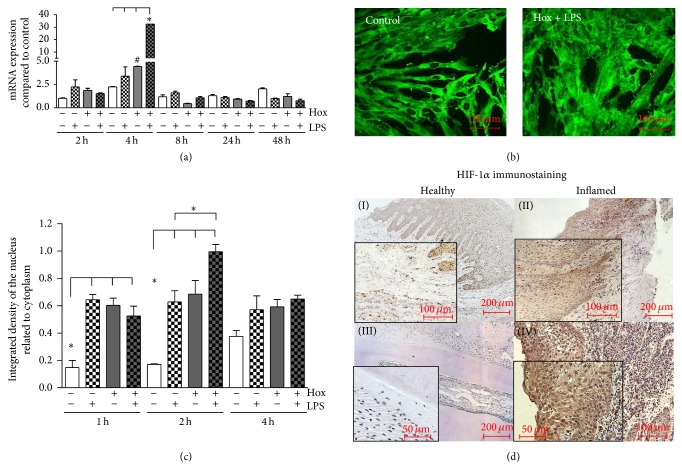Figure 4.
Activation of HIF-1α. (a) PDL cells were incubated for the indicated time periods with LPS-PG under normoxic or hypoxic conditions. HIF-1α mRNA expression was quantitated by real-time PCR, and expression levels were calculated as n-fold induction of the respective time matched untreated normoxic control. Statistical differences were analyzed by one-way ANOVA followed by different post hoc tests (Dunnett's and Tukey's multiple comparison test); # P < 0.05 depicts a significant difference with respect to time-matched control, * P < 0.05 indicates a significant difference between groups (means ± SD; n = 6). (b) PDL cells were cultured under normoxic (control) or hypoxic conditions (Hox) and stimulated with LPS-PG (1 μg/mL). HIF-1α protein was visualized by immunofluorescence staining. Representative pictures of cells under normoxic control conditions and after a 2-hour LPS-PG treatment under hypoxic conditions are shown. The scale bars indicate 100 μm. (c) PDL cells were incubated for 1, 2, and 4 hours. HIF-1α protein was detected by immunofluorescence. Density of nuclear HIF-1α staining was determined as in relation to total cell area using the freely available image-processing software ImageJ 1.43 (http://rsb.info.nih.gov/ij). Statistical analysis of the processed data were performed by one-way ANOVA followed by Tukey's multiple comparison test; * P < 0.05 indicates a significant difference between groups (means ± SD; n = 6). (d) Tissue samples from healthy gingiva (I), gingivitis (II), healthy periodontal ligament (III), and periodontitis (IV) were obtained after approval of the Ethics Committee of the University of Bonn and parental as well as patients' written consent (n = 3). Polyclonal primary antibody raised against HIF-1 was used in a concentration of 1 : 100 for immunohistochemistry. We observed an increase of HIF-1α immunostaining in accordance to the progression of periodontal inflammation. The scale bars indicate 50, 100, or 200 μm in dependence of the magnifications.

